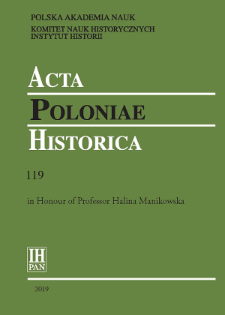- Search in all Repository
- Literature and maps
- Archeology
- Mills database
- Natural sciences
Advanced search
Advanced search
Advanced search
Advanced search
Advanced search

Object
Title: Early Urban Communes under German Law in Halyč-Volhynian Rus’ (the Thirteenth to the Mid-Fourteenth Century)
Subtitle:
Acta Poloniae Historica T. 119 (2019), In Honour of Professor Halina Manikowska
Contributor:
Korecki, Tristan : Tł. ; Instytut Historii Polskiej Akademii Nauk ; Komitet Nauk Historycznych Polskiej Akademii Nauk
Publisher:
Instytut Historii im. Tadeusza Manteuffla Polskiej Akademii Nauk
Place of publishing:
Description:
Type of object:
Abstract:
From the late twelfth century onwards, the German law became a universal organisational pattern of urban communes spread across Central Europe. Yet, the type of urban commune developed under the German law exceeded the limes of Latin Europe and the bounds of Central Europe, and extended to the area of Rus’ – notably, the Halyč-Volhynian Principality – in as early as the thirteenth century. The new communal forms emerged as a group law for the arrivals flowing in from the West, mainly the Germans. These organisations, alien to Rus’, emerged within the former, and still functioning, vernacular urban layouts – in the large political and commercial centres of Halyč-Volhynian Rus’. Their development in multiple forms can be traced: initially, settlement of a group of comers from the West – as in Chełm after 1240; a commune of foreign guests, led by an alderman – as in Przemyśl and Lemberg (Lwów, L’viv) before 1300; a self-governed commune – as in Volodimer before 1324; a law-based city – as in Sanok in 1339. These new developments were reflected in the terms used to describe the new realities: it was then, in the thirteenth century, that the word městič (‘burgher’) appeared in Old Rus’ian, a derivative of město (initially denoting a ‘locus’ later on, ‘urbs’).
References:
Baran Aleksander, ‘Recepcja prawa niemieckiego w księstwie halicko-włodzimierskim w XIII i pierwszej połowie XIV w.’, in Mykola Bevz and Jurij Lukoms’kyj (eds.), Korol’ Danylo Romanovyč: kul’turna i deržavotvorča spadščyna joho doby (L’viv, 2016), 82–97.
Janeczek Andrzej, ‘Ile razy Przemyśl lokowano? Z zagadnień formowania gminy miejskiej na Rusi Halickiej w XIII-XIV wieku’, in Tadeusz Wasilewski (ed.) Inter Orientem et Occidentem. Studia z dziejów Europy Środkowowschodniej ofiarowane Profesorowi Janowi Tyszkiewiczowi w czterdziestolecie pracy naukowej (Warszawa, 2002), 103–15; German version: id., ‘Wie oft wurde Przemyśl gegründet? Zur Genese städtischer Gemeinden in der Haličer Rus’ im 13.–14. Jahrhundert’, in Eduard Mühle (ed.), Rechtsstadtgründungen im mittelalterlichen Polen, Städteforschung A/81 (Köln, 2011), 339–54.
Janeczek Andrzej, ‘Ząb kniazia Lwa. W kwestii wiarygodności przemyskiego przywileju wójtowskiego’, in Cezary Buśko et al. (eds.), Civitas et villa. Miasto i wieś w średniowiecznej Europie Środkowej (Wrocław and Praha, 2002), 177–89.
Ludat Herbert, ‘Zum Stadtbegriff im osteuropäischen Bereich’, in Herbert Jankuhn (ed.), Vor- und Frühformen der europäischer Stadt im Mittelalter, i (Göttingen, 1973), 77–91, reprint: id., Slaven und Deutsche im Mittelalter (Köln, 1982), 226–41.
Pašin Sergej S., ‘Goroda Galicko-volynskoj Rusi vtoroj poloviny XIII – pervoj poloviny XIV v. i magdeburgskoe pravo’, in Igor’ Ja. Frojanov (ed.), Genezis i razvitie feodalizma v Rossii. Problemy istorii goroda (Leningrad, 1988), 139–45.
Relation:
Volume:
Start page:
End page:
Detailed Resource Type:
Format:
Resource Identifier:
oai:rcin.org.pl:81804 ; 0001-6829 ; 2450-8462 ; 10.12775/APH.2019.119.04
Source:
IH PAN, sygn. A.295/119 Podr. ; IH PAN, sygn. A.296/119 ; click here to follow the link
Language:
Rights:
Licencja Creative Commons Uznanie autorstwa-Bez utworów zależnych 4.0
Terms of use:
Zasób chroniony prawem autorskim. [CC BY-ND 4.0 Międzynarodowe] Korzystanie dozwolone zgodnie z licencją Creative Commons Uznanie autorstwa-Bez utworów zależnych 4.0, której pełne postanowienia dostępne są pod adresem: ; -
Digitizing institution:
Instytut Historii Polskiej Akademii Nauk
Original in:
Biblioteka Instytutu Historii PAN
Projects co-financed by:
Narodowy Program Rozwoju Humanistyki
Access:
Object collections:
- Digital Repository of Scientific Institutes > Partners' collections > Institute of History PAS > Serials
- Digital Repository of Scientific Institutes > Partners' collections > Institute of History PAS > Institute Publications
- Digital Repository of Scientific Institutes > Partners' collections > Institute of History PAS > Institute Publications > Journals
- Digital Repository of Scientific Institutes > Partners' collections > Institute of History PAS > Institute Publications > Journals > Acta Poloniae Historica
- Digital Repository of Scientific Institutes > Literature > Journals/Articles
Last modified:
Sep 22, 2023
In our library since:
Oct 1, 2019
Number of object content downloads / hits:
173
All available object's versions:
https://rcin.org.pl./publication/104503
Show description in RDF format:
Show description in RDFa format:
Show description in OAI-PMH format:
Objects Similar
Lutsyk, Iryna Bulyk, Natalia
Szmoniewski, Bartlomiej Szymon Stănică, Aurel Daniel
Kouřil, Pavel Přichystal, Antonín
Janeczek, Andrzej (1954– )
Janeczek, Andrzej (1954– )
Janeczek, Andrzej (1954– )

 INSTYTUT ARCHEOLOGII I ETNOLOGII POLSKIEJ AKADEMII NAUK
INSTYTUT ARCHEOLOGII I ETNOLOGII POLSKIEJ AKADEMII NAUK
 INSTYTUT BADAŃ LITERACKICH POLSKIEJ AKADEMII NAUK
INSTYTUT BADAŃ LITERACKICH POLSKIEJ AKADEMII NAUK
 INSTYTUT BADAWCZY LEŚNICTWA
INSTYTUT BADAWCZY LEŚNICTWA
 INSTYTUT BIOLOGII DOŚWIADCZALNEJ IM. MARCELEGO NENCKIEGO POLSKIEJ AKADEMII NAUK
INSTYTUT BIOLOGII DOŚWIADCZALNEJ IM. MARCELEGO NENCKIEGO POLSKIEJ AKADEMII NAUK
 INSTYTUT BIOLOGII SSAKÓW POLSKIEJ AKADEMII NAUK
INSTYTUT BIOLOGII SSAKÓW POLSKIEJ AKADEMII NAUK
 INSTYTUT CHEMII FIZYCZNEJ PAN
INSTYTUT CHEMII FIZYCZNEJ PAN
 INSTYTUT CHEMII ORGANICZNEJ PAN
INSTYTUT CHEMII ORGANICZNEJ PAN
 INSTYTUT FILOZOFII I SOCJOLOGII PAN
INSTYTUT FILOZOFII I SOCJOLOGII PAN
 INSTYTUT GEOGRAFII I PRZESTRZENNEGO ZAGOSPODAROWANIA PAN
INSTYTUT GEOGRAFII I PRZESTRZENNEGO ZAGOSPODAROWANIA PAN
 INSTYTUT HISTORII im. TADEUSZA MANTEUFFLA POLSKIEJ AKADEMII NAUK
INSTYTUT HISTORII im. TADEUSZA MANTEUFFLA POLSKIEJ AKADEMII NAUK
 INSTYTUT JĘZYKA POLSKIEGO POLSKIEJ AKADEMII NAUK
INSTYTUT JĘZYKA POLSKIEGO POLSKIEJ AKADEMII NAUK
 INSTYTUT MATEMATYCZNY PAN
INSTYTUT MATEMATYCZNY PAN
 INSTYTUT MEDYCYNY DOŚWIADCZALNEJ I KLINICZNEJ IM.MIROSŁAWA MOSSAKOWSKIEGO POLSKIEJ AKADEMII NAUK
INSTYTUT MEDYCYNY DOŚWIADCZALNEJ I KLINICZNEJ IM.MIROSŁAWA MOSSAKOWSKIEGO POLSKIEJ AKADEMII NAUK
 INSTYTUT PODSTAWOWYCH PROBLEMÓW TECHNIKI PAN
INSTYTUT PODSTAWOWYCH PROBLEMÓW TECHNIKI PAN
 INSTYTUT SLAWISTYKI PAN
INSTYTUT SLAWISTYKI PAN
 SIEĆ BADAWCZA ŁUKASIEWICZ - INSTYTUT TECHNOLOGII MATERIAŁÓW ELEKTRONICZNYCH
SIEĆ BADAWCZA ŁUKASIEWICZ - INSTYTUT TECHNOLOGII MATERIAŁÓW ELEKTRONICZNYCH
 MUZEUM I INSTYTUT ZOOLOGII POLSKIEJ AKADEMII NAUK
MUZEUM I INSTYTUT ZOOLOGII POLSKIEJ AKADEMII NAUK
 INSTYTUT BADAŃ SYSTEMOWYCH PAN
INSTYTUT BADAŃ SYSTEMOWYCH PAN
 INSTYTUT BOTANIKI IM. WŁADYSŁAWA SZAFERA POLSKIEJ AKADEMII NAUK
INSTYTUT BOTANIKI IM. WŁADYSŁAWA SZAFERA POLSKIEJ AKADEMII NAUK


































